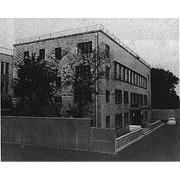The movement to mechanize office processing took off in Japan in the second half of the 1950s, and alongside this movement came a rising interest in the nascent electronic computer industry. A study into electronic computers began in April 1955 with the formation of the Computer Study Group (chaired by Yamashita Hideo) under the auspices of the Radio Engineering and Electronics Association. Based on the findings of the two-year study, a joint development project was planned with the development of various computer components to be shared by various manufacturers. The project got underway with guidance and funding from the Ministry of International Trade and Industry. The Ministry of International Trade and Industry attempted to stimulate the electronics industry by enacting the Law on Temporary Stimulation Measures for the Electronics Industry in June 1957. This had the effect of paying out subsidies to R&D into electronic computers and peripheral devices, to performance enhancements, and to production rationalization as well as financing manufacturing facility improvement.
On April 26, 1958, 26 manufacturers jointly established the Japan Electronics Industry Development Association (JEIDA) with the authorization of the Minister for International Trade and Industry. Following the intent of the Law on Temporary Stimulation Measures for the Electronics Industry, JEIDA’s objectives were to promote the study and research of leading technologies, to rationalize production, and to popularize the adoption of electronics. Saito Yu transferred from Radio Engineering and Electronics Association to serve as the first chairman of JEIDA. Similarly, the activities of the Computer Study Group were shifted to JEIDA. The first activities at JEIDA were interconnection tests of various components prototyped by different manufacturers. While a whole system was not finalized, beneficial results were obtained from prototypes of peripheral devices and memory units.
JEIDA set up the Electronic Computer Center in November 1958. This became the venue for new domestic computer developments and performing real-world calculations as well as a PR showroom for the general public, with data showing the performance, reliability, and stability of computers. The Center also made huge contributions in promoting computer use in Japan by creating libraries of programs, developing new programmers, offering consultant services, and providing for-fee calculation services.
JEIDA merged with the Electronic Industries Association of Japan (EIAJ) and became the Japan Electronics and Information Technology Industries Association (JEITA) in April 1, 2000.


